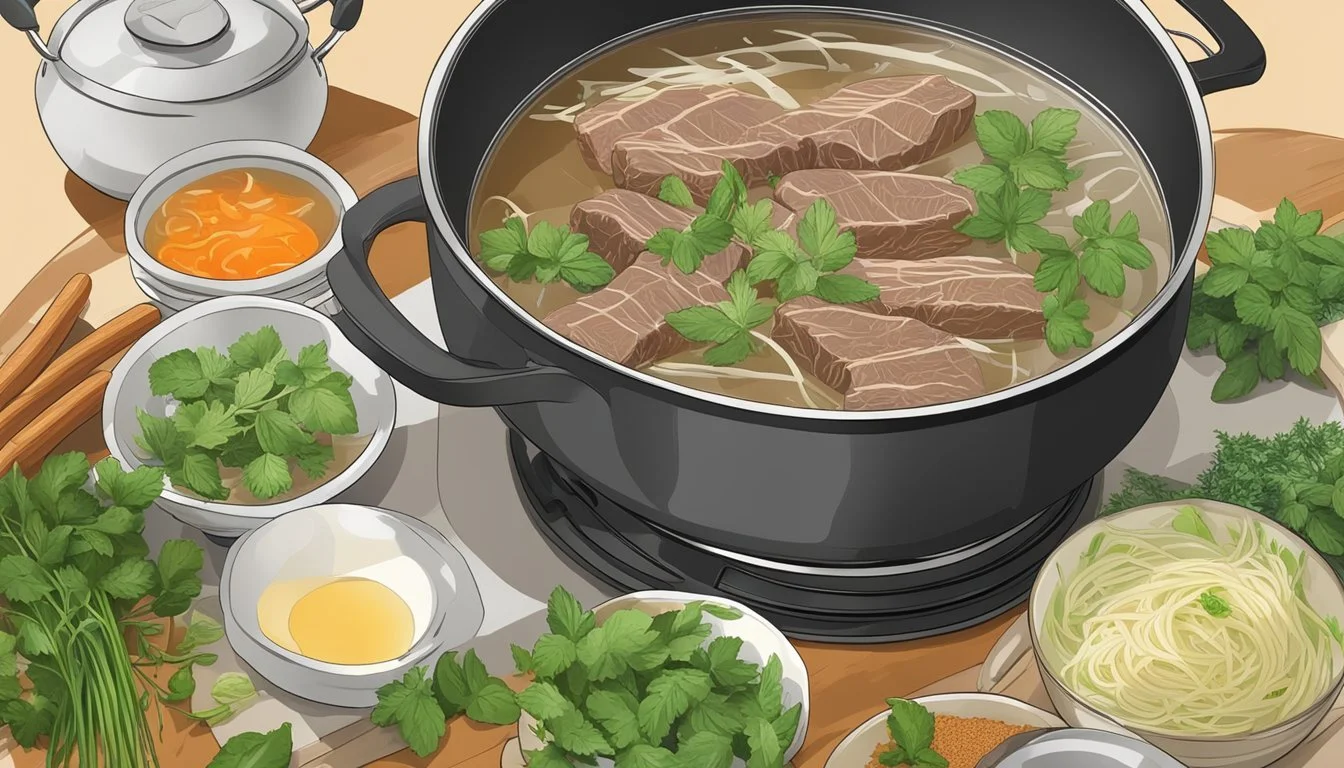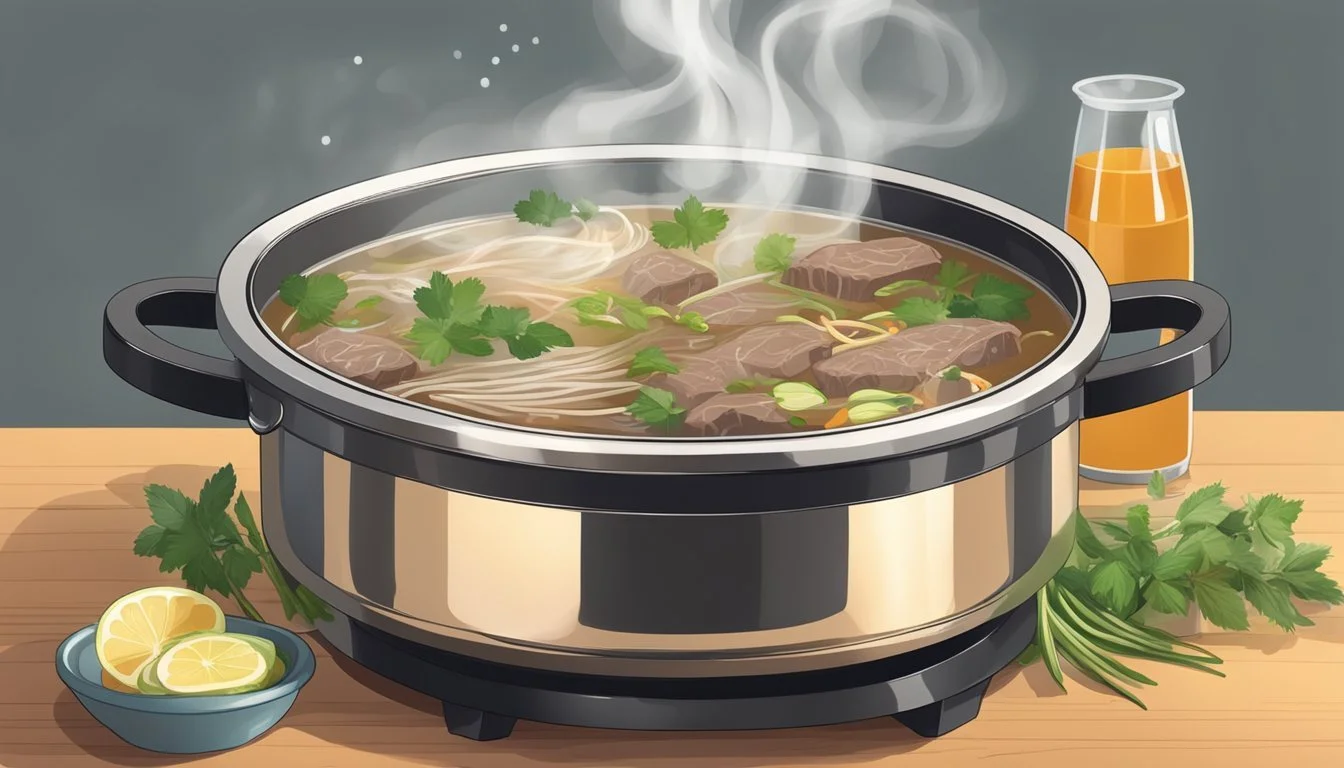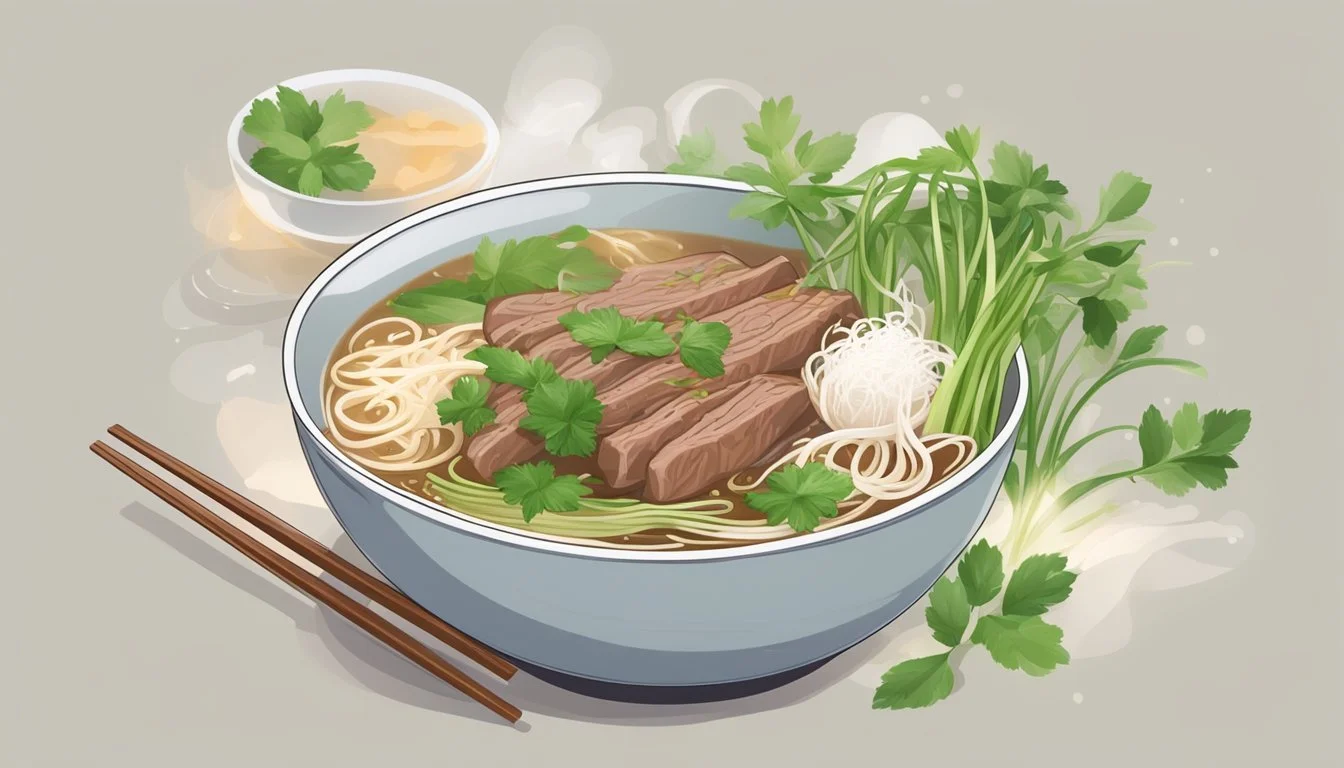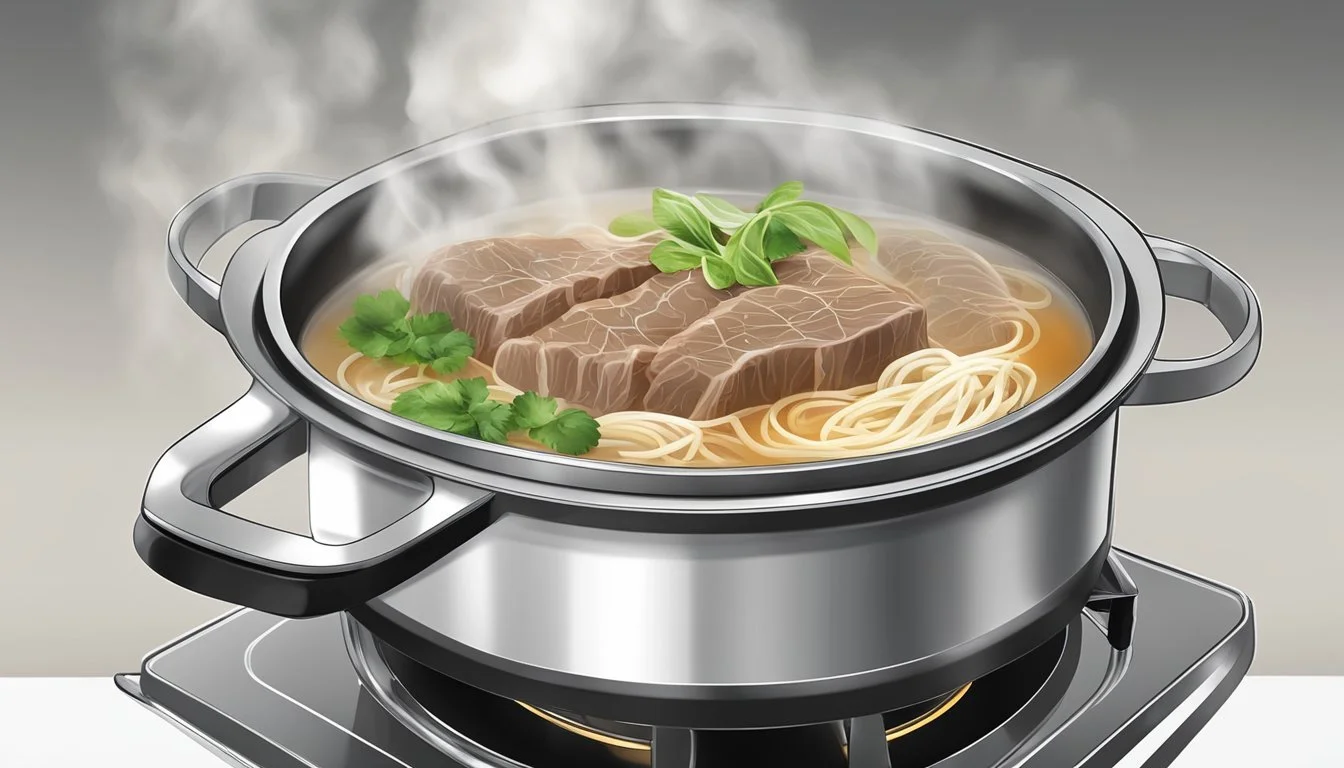Best Way to Reheat Beef Pho
Preserving Clarity and Aroma of Your Broth
Reheating beef pho requires a delicate balance to ensure the clarity of the broth and the preservation of its aromatic qualities. The leftover soup, a Vietnamese staple made from beef stock, spices, and rice noodles, often becomes a staple in homes the day after it's made. However, retaining the essence of the fresh dish's warm, spiced, and inviting flavors can be challenging. Special attention must be given to the components of pho, particularly the broth, which can become cloudy and lose its aromatic complexity if not handled correctly during reheating.
The key to successfully reheating beef pho lies in the separation and individual treatment of its components. Noodles, meat, and vegetables, initially set aside at room temperature, should be reincorporated into the broth only after it has returned to a near-boiling state. This maintains the clarity of the broth and the texture of the noodles and toppings, while ensuring the beef remains tender. The process must be gentle and gradual to prevent overcooking, which can spoil the flavors and textures that are the heart of a good bowl of pho.
Understanding Pho
In this section, the reader will gain insights into the rich history and traditional components that make Pho a distinguished Vietnamese dish, particularly focusing on beef pho as a central variant.
History of Vietnamese Pho
Pho, a Vietnamese noodle soup, has its roots entrenched in the early 20th century in northern Vietnam. It emerged as a hearty staple combining French and Chinese culinary influences. Initially a street food sold at dawn and dusk by mobile vendors, Pho gained prominence and became an embodiment of Vietnamese cuisine. As the dish traversed from North to South, it metamorphosed subtly, incorporating regional tastes and ingredients.
Key Ingredients of Pho
A traditional bowl of beef pho, or "Pho Bo" in Vietnamese, typically comprises of:
Broth: Clear and aromatic, it's simmered with a combination of charred onions, ginger, star anise, cloves, cinnamon, and cardamom along with beef bones and water.
Rice Noodles (Bánh Phở): Thin, flat rice noodles are a foundational element providing the distinct texture.
Beef: Slices of raw beef are placed in the bowl and cooked gently by the hot broth poured over them, resulting in tender, flavorful meat.
Herbs and Additions:
Fresh herbs (like cilantro, basil, and green onions)
Bean sprouts
Lime wedges
Chili peppers
Fish sauce and hoisin sauce for accompaniment
This combination of spiced broth, rice noodles, beef, and fresh herbs not only provides a complex array of flavors but also allows beef pho to stand out as a quintessential Vietnamese noodle soup known for its clarity and aroma.
Preparing Beef Pho
Before diving into the nuances of reheating beef pho, it is essential to start with its preparation. Crafting the perfect bowl of beef pho lies in the balance of aromatic broth, quality beef, and the complementary garnishes that offer both flavor and texture.
Assembling the Perfect Bowl
To assemble an exemplary bowl of pho, one must begin with the broth—the soul of the dish. A clear and aromatic broth is achieved through simmering bones and a precise blend of spices such as star anise, cloves, cinnamon, cardamom, and coriander seeds for several hours. This process extracts maximum flavor while maintaining clarity. The noodles used should be thin rice noodles, cooked just until tender, ensuring they do not become mushy.
The symphony of flavors in the bowl is accentuated by fresh herbs and garnishes. The dish is typically served with a generous plate of bean sprouts, basil, and cilantro, allowing diners to add to their taste. Lime wedges lend a zesty acidity, while hoisin sauce and sriracha provide sweet and spicy notes respectively. When adding these toppings, it's important to encourage diners to tailor the garnishes to their personal flavor preferences.
Choosing Quality Beef
The choice of beef is paramount to the authenticity and taste of pho. Traditionally, pho utilizes multiple cuts of beef, each bringing a different texture and richness to the bowl. Choices can range from sirloin to brisket, flank, or tendon. The beef should be sliced paper-thin; this not only ensures that it cooks quickly once in contact with the hot broth but also maintains a tender bite. Freshness of the beef is a non-negotiable; it contributes to the clean, distinct meat flavor essential to a superior pho experience.
Storing Beef Pho
When stowing leftover pho, one must consider both refrigeration and freezing based on when they plan to consume it. Optimal storage preserves the integrity of noodles, meats, and broth, resulting in a more enjoyable reheating experience.
Refrigeration Tips
For short-term storage of leftover pho, one should place the components in the refrigerator within two hours of cooking to prevent harmful bacteria growth. Using an airtight container helps to maintain the broth's clarity and aroma:
Broth: Store in a separate container to avoid sogginess of noodles and meats.
Noodles and Meats: Keep them in another airtight container to retain texture.
It is recommended to consume refrigerated pho within three days.
Freezing and Thawing
For freezing, it is imperative to understand that not all components of pho freeze equally:
Broth: Can be frozen effectively. Allow it to cool to room temperature first, then transfer to a freezer-safe bag or container.
Noodles: Best to avoid freezing as they will become mushy when thawed.
Meats: Can be frozen if separated from the broth. Wrap well to prevent freezer burn.
Pho should be thawed in the refrigerator overnight for best results. Avoid using the microwave for thawing as it may unevenly heat the components. Once thawed, consume immediately and never refreeze previously frozen pho.
Reheating Techniques
To ensure that beef pho is reheated to a steaming yet clear broth with a maintained aromatic quality, careful application of heat is essential. The following methods offer controlled reheating to prevent the broth from becoming murky and to retain its flavorful essence.
Stovetop Simmering
The stovetop method allows for precise temperature control. One should:
Transfer the broth to a pot.
Heat it gently on the stove, bringing it to a simmer and not a boil to maintain clarity.
The hot broth should then be poured over the other components, which can be warmed separately, to ensure even heating.
Microwave Reheating
The microwave provides a quick reheating option. To reheat beef pho in the microwave:
Place the broth in a microwave-safe container, preferably covered with a microwave-safe lid to trap steam.
Microwave it on high power in increments of 30 seconds, stirring in between to distribute heat evenly.
Using an Oven
Reheating beef pho in the oven is a less common but effective method, especially for large portions:
Preheat the oven to a moderate temperature to avoid overheating.
One can place the broth in an oven-safe dish, covered with foil to keep it from reducing too much.
Heat until warm, checking frequently to ensure the flavorful broth remains aromatic and doesn't lose its clear quality.
Maintaining Clarity and Aroma
When reheating beef pho, the goal is to keep the broth clear and the aromatic essence intact. Proper technique ensures that the broth remains fragrant and rich, enhancing the overall pho experience.
Avoiding Cloudiness
Simmering: Gently simmer the broth on a low to medium heat. Vigorous boiling should be avoided as it can emulsify fats into the broth, causing cloudiness.
Skimming: As the broth reheats, impurities may rise to the surface. Skimming these off periodically helps maintain a clear broth.
Preserving Aromatic Qualities
Gradual Heating: Slowly reheat the broth to prevent the aromatic compounds from dissipating quickly.
Adding Aromatics: If the original aroma has diminished, one might consider enhancing the broth with fresh aromatic ingredients like ginger or star anise during the reheating process, but they should be removed before serving to maintain clarity.
Enhancing the Flavor After Reheating
After reheating your beef pho, the focus shifts to reviving its vibrant flavors. This section provides guidance on using garnishes, toppings, and balanced spices to ensure an authentic and aromatic experience.
Additional Garnishes and Toppings
One can enhance the complexity of pho with a variety of fresh garnishes and toppings. They serve not only as flavor enhancers but also add a refreshing contrast to the rich broth. Consider incorporating the following:
Fresh Herbs: A generous handful of Thai basil and cilantro adds a fragrant aroma and a burst of freshness.
Citrus: Squeeze lime juice to introduce a zesty brightness that complements the savory broth.
Chilies: Thin slices of Thai chili lend a spicy kick.
Crunchy Elements: Bean sprouts and sliced onions offer a satisfying crunch and nuanced flavors.
Balancing the Spices
A discerning palate may wish to fine-tune the spices to achieve that quintessential Vietnamese taste:
Fish Sauce: Add a few drops at a time, tasting as you go, to heighten the umami without overpowering the broth.
Sugar: A pinch can balance the spices, adding a subtle sweetness and rounding out the flavors.
Pepper: Freshly cracked black pepper imbues warmth and a slight edge, contributing to the authentic character of the dish.
Avoiding Common Pitfalls
Ensuring that beef pho retains its clarity and aroma when reheated requires careful consideration to avoid common mistakes that can compromise the dish's quality. Overcooking can lead to a loss of texture and flavor, while improper reheating techniques can dry out the ingredients.
Preventing Overcooking
To maintain the tender texture and rich flavor of the beef pho, one must avoid overcooking:
Broth: Reheat the broth until it's just hot enough. Do not let it boil for too long.
Noodles: Separate noodles from broth when reheating. Warm noodles separately to avert them turning mushy.
Meat: Thinly sliced meat should be added to the bowl at the last moment to avoid overcooking—it will cook in the hot broth.
Veggies: Immerse in the hot broth for a brief period to preserve their crisp texture.
Reheating Without Drying Out
To reheat beef pho without drying out the components, the following guidance should be followed:
Broth: Always add a splash of water when reheating broth to counteract evaporation and concentrate the flavors.
Soup as a whole: Cover the pho while reheating to trap moisture and evenly distribute heat.
Noodles: Noodles should be dampened with a little water before warming them to prevent them from drying out.
Meat: Keep the meat covered and at room temperature prior to serving to ensure it remains moist.
By attending to these specifics, one can reheat beef pho effectively while maintaining the soup's delightful sensory appeal.
Conclusion
For those seeking to maintain the integrity of beef pho when reheating, it is essential to treat each component with care. Best practices suggest reheating the broth separately to preserve its flavor and aroma, which are the soul of the dish. A clear broth is achieved by gently reheating it to just below a simmer, avoiding a rolling boil which can make the broth cloudy and affect its delicate flavors.
The texture of the noodles is another critical aspect; they should be warmed separately to avoid overcooking. Fresh or previously cooked noodles can be blanched in hot water for just a few seconds until they are loosened and warmed through. This ensures they retain their distinctive chewiness.
Garnishes play a pivotal role in the final presentation and freshness of beef pho. They should be prepped fresh where possible and added only after the broth and noodles have been assembled. Properly warmed cuts of beef enhance the overall dish; using methods like sous vide can ensure the meat remains tender and flavorful.
In summary, the components of beef pho must be approached with consideration:
Broth: Reheat gently to avoid cloudiness and maintain aroma.
Noodles: Warm separately to preserve texture.
Beef: Heat to the right temperature for tenderness.
Garnishes: Add fresh to serve.
Adhering to these methods guarantees that the reheated beef pho will echo the experience of a freshly-made bowl, rich in taste and tradition.
Frequently Asked Questions
How should you store beef pho for reheating?
Beef pho should be stored in separate containers for the broth and ingredients. The broth can be kept in an airtight container, while meats, noodles, and vegetables should also be refrigerated in separate containers to maintain quality and ease the reheating process.
What is the best way to reheat beef pho to preserve its clear broth and aroma?
For a clear and aromatic broth, reheat the broth by itself. Bring it to a gentle boil on the stove, then pour it over room temperature ingredients such as noodles, meats, and vegetables in a bowl.
Can reheating beef pho affect its calorie and fiber content?
The calorie and fiber content of beef pho should not be altered significantly through reheating. However, it's important to avoid overcooking the ingredients to ensure the dish maintains its nutritional value.
How do you reheat pho without losing flavor?
To keep the flavor intact, reheat the components of pho separately. Heat the broth to just boiling, and gently warm the noodles and meats, avoiding direct high heat which can diminish the flavor.
Should any parts of pho be discarded before reheating?
Discard any garnishes like fresh herbs before storing leftover pho. They do not reheat well and are best added fresh when the dish is served after reheating.







